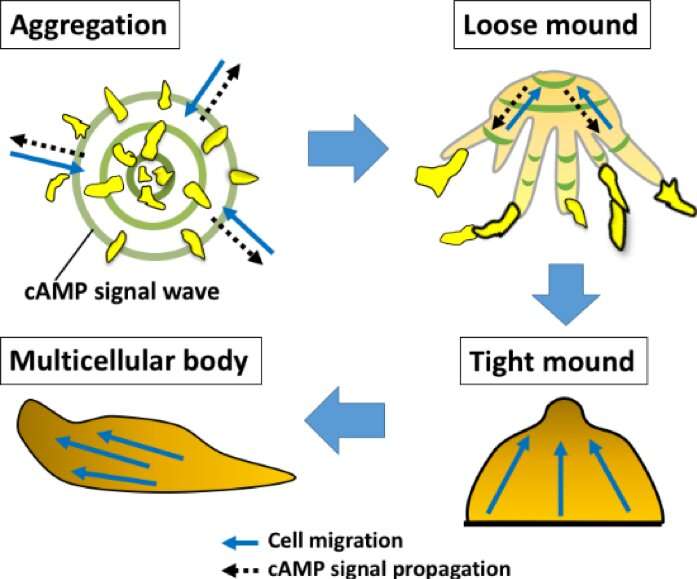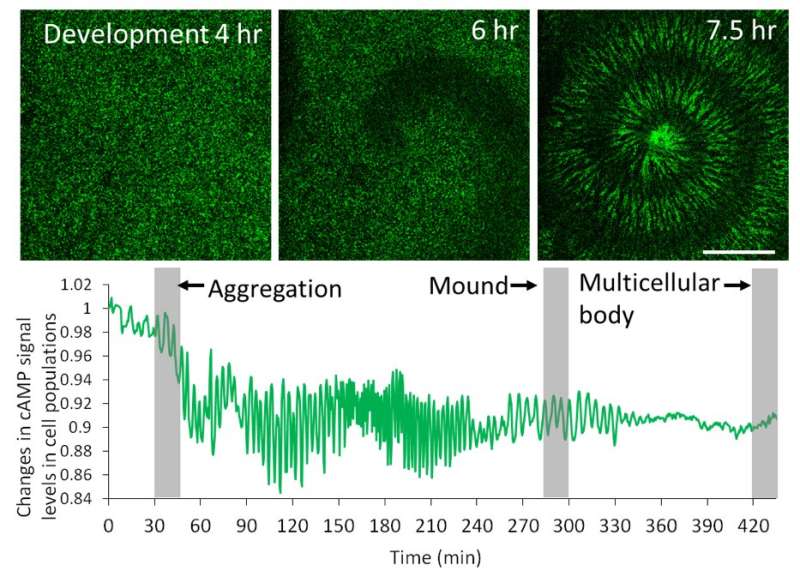Aggregated social amoebae need physical contact rather than chemical signals for motivation

Collective cell migration, in which groups of cells move together with a common purpose, is important for processes ranging from wound healing to tumor metastasis. Migrating cells respond to a combination of physical cues elicited by cell-to-cell contact and waves of chemical signals sent out by local cells to attract others to their location.
Recently, however, a team led by researchers from Osaka University have found that this combined approach may not be the case for cells at all stages of development.
In the study published recently in Communications Biology, the researchers used model organism Dictyostelium discoideum to better understand the cues controlling collective cell migration during development. Referred to as social amoebae, unicellular D. discoideum cluster together in times of stress to form a multicellular aggregate called a slug.
Though their less-than-enticing name may inspire shudders in readers who have encountered their animal namesake, cells within the slugs seem to like getting up-close and personal: the researchers found that while free-living cells respond to waves of chemical stimuli, slug cells require physical interaction to induce migration.
Hidenori Hashimura, lead author of the study, explained how they used changes in the intensity of chemical signals to deduce the importance of this type of signalling at different developmental stages. "Cyclic adenosine 3ʹ,5ʹ-monophosphate (cAMP) is the only chemical guidance cue for cell aggregation. Using live cell imaging, we clearly observed waves of cAMP, which can be visualized using a green fluorescent probe, during the initial stages of cell aggregation," says corresponding author Yusuke V. Morimoto. However, it was revealed that the cAMP signals gradually disappeared during migration of the multicellular slugs.
"We found that the cAMP propagation waves thought to control mass cellular movement during all stages of Dictyostelium development actually disappeared once the cells aggregated into multicellular slugs," explains co-author Masahiro Ueda. "Although cell movement within the slugs was equal to that of cells in the early aggregation stage, the absence of cAMP signal waves suggested an alternative cue for collective cell migration."
The researchers proposed that "contact following," where physical contact between cells allows them to follow each other, is likely to be responsible for collective cell migration during the slug phase of Dictyostelium development.
This is the first time researchers have examined cAMP signal dynamics in the multicellular phase of Dictyostelium development and highlights the importance of examining cellular processes at all stages of development. More importantly, understanding collective cell migration cues is a vital step in developing methods to prevent metastatic cancer and promote wound healing.

More information: Hidenori Hashimura et al. Collective cell migration of Dictyostelium without cAMP oscillations at multicellular stages, Communications Biology (2019). DOI: 10.1038/s42003-018-0273-6
Provided by Osaka University


















